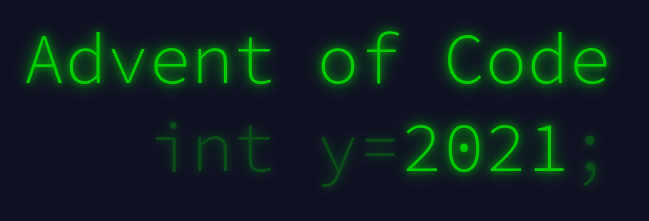
Part 1
Now, you need to figure out how to pilot this thing.
It seems like the submarine can take a series of commands like forward 1, down 2, or up 3:
forward Xincreases the horizontal position byXunits.down Xincreases the depth byXunits.up Xdecreases the depth byXunits.
Note that since you're on a submarine, down and up affect your depth, and so they have the opposite result of what you might expect.
The submarine seems to already have a planned course (your puzzle input). You should probably figure out where it's going. For example:
forward 5
down 5
forward 8
up 3
down 8
forward 2
Your horizontal position and depth both start at 0. The steps above would then modify them as follows:
forward 5adds5to your horizontal position, a total of5.down 5adds5to your depth, resulting in a value of5.forward 8adds8to your horizontal position, a total of13.up 3decreases your depth by3, resulting in a value of2.down 8adds8to your depth, resulting in a value of10.forward 2adds2to your horizontal position, a total of15.
After following these instructions, you would have a horizontal position of 15 and a depth of 10. (Multiplying these together produces _150_.)
Calculate the horizontal position and depth you would have after following the planned course. What do you get if you multiply your final horizontal position by your final depth?
Proposed solution: iterate through the input while keeping track of position and depth
Time complexity: O(n)
Space complexity: O(1)
#!/usr/bin/env python3
import sys
if len(sys.argv) != 2:
print("Usage: {} <input file>".format(sys.argv[0]))
sys.exit(1)
file_input = open(sys.argv[1], "r").read().strip().split("\n")
data = list(map(lambda x: x.split(" "), file_input))
position, depth = 0, 0
for instruction in data:
instruction_type = instruction[0]
instruction_val = int(instruction[1])
if instruction_type == "forward":
position += instruction_val
elif instruction_type == "up":
depth -= instruction_val
elif instruction_type == "down":
depth += instruction_val
print("Final position * depth = " + str(position * depth))In this case, I made a secondary list which contains space-delimited lists for each line. Memory is not so important just yet. This can be done in-place though.
#!/usr/bin/env python3
import sys
if len(sys.argv) != 2:
print("Usage: {} <input file>".format(sys.argv[0]))
sys.exit(1)
file_input = open(sys.argv[1], "r").read().strip().split("\n")
position, depth = 0, 0
for instruction in file_input:
instruction_type, instruction_val = instruction.split()
instruction_val = int(instruction_val)
if instruction_type == "forward":
position += instruction_val
elif instruction_type == "up":
depth -= instruction_val
elif instruction_type == "down":
depth += instruction_val
print("Final position * depth = " + str(position * depth))❯ python3 solution2.py input2
Final position * depth = 2120749Part 2
Based on your calculations, the planned course doesn't seem to make any sense. You find the submarine manual and discover that the process is actually slightly more complicated.
In addition to horizontal position and depth, you'll also need to track a third value, aim, which also starts at 0. The commands also mean something entirely different than you first thought:
down Xincreases your aim byXunits.up Xdecreases your aim byXunits.forward Xdoes two things:- It increases your horizontal position by
Xunits. - It increases your depth by your aim multiplied by
X.
Again note that since you're on a submarine, down and up do the opposite of what you might expect: "down" means aiming in the positive direction.
Now, the above example does something different:
forward 5adds5to your horizontal position, a total of5. Because your aim is0, your depth does not change.down 5adds5to your aim, resulting in a value of5.forward 8adds8to your horizontal position, a total of13. Because your aim is5, your depth increases by8*5=40.up 3decreases your aim by3, resulting in a value of2.down 8adds8to your aim, resulting in a value of10.forward 2adds2to your horizontal position, a total of15. Because your aim is10, your depth increases by2*10=20to a total of60.
After following these new instructions, you would have a horizontal position of 15 and a depth of 60. (Multiplying these produces _900_.)
Using this new interpretation of the commands, calculate the horizontal position and depth you would have after following the planned course. What do you get if you multiply your final horizontal position by your final depth?
Proposed solution: same thing but new calculations while keeping track of aim
Time complexity: O(n)
Space complexity: O(1)
#!/usr/bin/env python3
import sys
if len(sys.argv) != 2:
print("Usage: {} <input file>".format(sys.argv[0]))
sys.exit(1)
file_input = open(sys.argv[1], "r").read().strip().split("\n")
position, depth, aim = 0, 0, 0
for instruction in file_input:
instruction_type, instruction_val = instruction.split()
instruction_val = int(instruction_val)
if instruction_type == "forward":
position += instruction_val
depth += instruction_val * aim
elif instruction_type == "up":
aim -= instruction_val
elif instruction_type == "down":
aim += instruction_val
print("Final position * depth = " + str(position * depth))Now our up and down instructions modify the aim instead of the depth directly. Only on the forward instruction do we adjust depth with aim as a factor.
❯ python3 solution2.py input2
Final position * depth = 2138382217